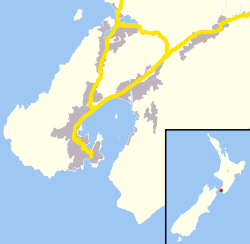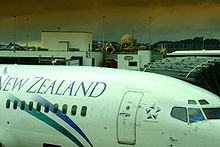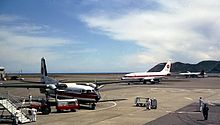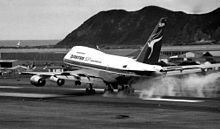- Wellington International Airport
-
Wellington International Airport 
Aerial photo of Wellington International Airport (north to left) IATA: WLG – ICAO: NZWN Location of the Wellington International Airport Summary Airport type Public Owner Infratil, Wellington City Council Operator Wellington International Airport Ltd Serves Wellington, New Zealand Location Rongotai, Wellington, New Zealand Elevation AMSL 13 m / 42 ft Coordinates 41°19′38″S 174°48′19″E / 41.32722°S 174.80528°E Website Runways Direction Length Surface m ft 16/34[1] 1,934 6,351 Grooved bitumen Statistics (2008[2]) Passenger throughput 5,021,000 Aircraft movements 111,270 Gollum peering over the terminal building at Wellington Airport during a promotion for the Lord of the Rings movies - June 2004
Wellington International Airport (formerly known as Rongotai Airport) (IATA: WLG, ICAO: NZWN) is an international airport located in the suburb of Rongotai in Wellington, the capital city of New Zealand. It is a secondary hub and focus city for Air New Zealand and its subsidiaries. The airport is operated by Wellington International Airport Limited, a joint venture between Infratil and the Wellington City Council.
Wellington is the third-busiest airport in New Zealand (after Auckland and Christchurch), with a total of 5.021 million passengers and 111,000 aircraft movements in 2008. The airport, in addition to linking to many New Zealand destinations by national and regional carriers, also has links to major cities in eastern Australia and Fiji. It is the home of many smaller general aviation businesses, including Wellington Aero Club, which operates from the general aviation area on the western side of the runway.
The airport is on a small 110-hectare (270-acre)[3] site on the Rongotai isthmus, a stretch of low-lying land between Wellington proper and the Miramar Peninsula. It operates a single 1,936-metre (6,352 ft) runway with ILS in both directions, capable of handling aircraft up to the Boeing 767-300 and Airbus A330-200 (although the largest aircraft to use Wellington in regular service in 2010 are the Airbus A320 and the Boeing 737-800). The airport is bordered by residential and commercial areas to the east and west, and Wellington Harbour and Cook Strait to the north and south respectively.
Wellington has a reputation of having rough and turbulent landings, even in larger aircraft, due to the channelling effect of Cook Strait creating significant crosswinds to an aircraft approaching from the south.[4][5]
Contents
History
Rongotai Airport started with a grass runway in November 1929.[6] The airport opened in 1935,[7] but was closed down due to safety reasons on 27 September 1947 (grass surface often became unusable during winter months).[8] During the closure, Paraparaumu Airport, 35 miles north of Wellington, was Wellington's airport, and became the country's busiest airport in 1949.
A proposal to relocate the terminal from the east side to the site of the Miramar Golf Course was put forward in 1956.[9] Houses were moved to make way for the construction of the new Wellington Airport in 1958.[10] The current airport was officially reopened on 25 October 1959,[11] after lobbying by the local Chamber of Commerce for a location that was much closer to the city centre.[12] Paraparaumu Airport was deemed unsuitable for large planes due to adverse terrain. The original length of the runway was 1630 m (5350 ft),[13] and was extended to its current length of 1936 m in the early 1970s, to handle DC-8s.
Wellington's original domestic terminal was built as a temporary measure inside a corrugated iron hangar, originally used to assemble de Havilland aircraft. It was known for being overcrowded, leaky and draughty. This building remained visible from the SoundsAir Terminal from which a covered walkway used to link the old Terminal to the new one, but has since been removed. An upgrade of the domestic terminal, budgeted at NZ$10 million, was announced in 1981, but by 1983 the plans were shelved after cost projections more than doubled.[14] The terminal was extensively refurbished in 1986 by Air New Zealand, and Ansett New Zealand built a new terminal as an extension to the international terminal when it commenced competing domestic air services in 1986.
In 1991, the airport released plans to widen the taxiway to CAA Code D & E specifications[15] and acquire extra space,[16] which were abandoned after protests from local residents. The plan involved the removal of the nearby Miramar Golf Course and a large number of residential and commercial properties.[17] The Airport purchased land from the Miramar Golf Course in 1994 for car park space.
As recently as 1992, several alternate sites for Wellington Airport were considered - Te Horo, Paraparaumu, Mana Island, Ohariu Valley, Horokiwi, Wairarapa and Pencarrow -[18] but a decision was made to upgrade the existing site at Rongotai. A major new terminal was completed in 1999 and integrated with the international terminal, which had been built as an abortive first stage of a whole new terminal in 1977, and a 90 m safety zone at the south end of the runway has been constructed in order to comply with ICAO safety regulations. A similar zone has been put in place at the runway's north end.[19]
Since 1998 the airport has been two-thirds privately owned by Infratil, with the remaining third owned by the Wellington City Council.
In late 2003 the airport installed a large statue of Gollum on the terminal in order to promote the world premiere of The Lord of the Rings: The Return of the King, since removed.
In April 2006, Air New Zealand and Qantas announced that they proposed to enter into a codeshare agreement, arguing that it would be necessary in order to reduce empty seats and financial losses on trans-Tasman routes. The airport counter-argued that the codeshare would stifle competition and passenger growth on Wellington's international flights, pointing to what it saw as a market duopoly dominated by Air New Zealand and Qantas.[20] The codeshare was abandoned by the two airlines after it was rejected in a draft ruling by the ACCC in November 2006.[21]
Terminal and piers
Wellington Airport operates a single terminal at the east of the airport, with three piers: South, South-West and North-West. The terminal and piers have a total floor area of 32,300 square metres (348,000 sq ft).[2]
The main terminal building contains a common check-in area on the first floor and a common baggage claim area on the ground floor. Both connect to a large retail area on the first floor, looking out onto the runway. The main terminal has three gates, 18-20, which service small piston-engined and turboprop aircraft.[22]
The South Pier contains six gates (4-9) that serve regional aircraft and Air New Zealand Link turboprop aircraft. All are airstair gates. The South West Pier contains eight gates (10-17) and is used by Air New Zealand domestic turbofan and Link turboprop aircraft; gates 10, 11, 16, and 17 are jetbridge gates used by Boeing 737-300 aircraft. The North West Pier contains 13 gates (21-28, including 26a - 26f). Gates 21 to 24 are used by JetStar and Pacific Blue domestic services. Gates 25 to 28 serve all international flights.[22]
Air Movements Rongotai
Air Movements Rongotai sits on the opposite side of the Wellington airport runway from the main passenger terminals, its main use being the facilatation of RNZAF flights and flights of overseas military forces. The current building was built in the late 1980s when it housed not only the RNZAF Air movements unit but also 2 MCU (2nd Movements Control Unit) of the New Zealand army. The role of 2 MCU was the logistic control and movement of defence personal and freight throughout New Zealand and abroad, utilizing both civilian and military modes of transport.
Ongoing issues and development
Runway
The shortness of the runway has limited the size of aircraft that can use the airport, and possible overseas destinations are limited to a small number of destinations in Australasia and the Pacific. This has led to a de facto duopoly by Air New Zealand and Qantas on international flights out of Wellington.
At 1,936 metres (6,352 ft), Wellington's runway is shorter than some New Zealand domestic airport runways, including Palmerston North and Invercargill. The Boeing 737 and Airbus A320 aircraft currently using Wellington cannot take off when fully loaded, as their take-off run at maximum take-off weight (MTOW) is longer than the runway (2,300–2,550 m/7,500–8,370 ft for the 737 and 2,100 m/6,900 ft for the A320). More powerful larger mid-sized airliners such as the Boeing 757, Boeing 767 and Airbus A330-200 can take off with ease but regular passenger numbers do not warrant their use, although both Air New Zealand and Qantas fly in their Boeing 767-300s for one-off events such as international sports fixtures, and the Royal New Zealand Air Force fly in their Boeing 757 transport aircraft for transport of the Governor-General or Prime Minister.
Planes larger than the 767 and A330 have landed at Wellington, but not in regular revenue service.
- A Gulf Air Airbus A340-300 carrying the Bahrain national football team landed in November 2009 for the World Cup qualifier against New Zealand at Westpac Stadium.[23] However, the short runway meant on the outbound leg that the plane had to stop at Sydney for refuelling.
- On 9 February 2011, Air New Zealand landed its brand new Boeing 777-300ER ZK-OKM for a open day of the aircraft's new long-haul cabin. Special training was required by the crew to be able to land the largest twinjet in the world at Wellington.[24]
- Following the 22 February 2011 Christchurch earthquake, Air New Zealand utilised some of its Boeing 777-200ER fleet in evacuating people wanting to leave Christchurch and ferrying essential supplies into the city.[25] As the flights were only 300 km (190 mi) long, requiring little fuel, the aircraft could operate at full payload in and out of Wellington.
A full-length runway extension, to accommodate long-haul aircraft such as the Boeing 747, has been previously investigated,[16][26][27][28][29] but would require highly expensive land reclamation into Lyall Bay, and massive breakwater protection from Cook Strait. Doubts have existed over the viability of such an undertaking, particularly as Air New Zealand has repeatedly indicated that it has no interest in pursuing international service beyond Australia and the Pacific Islands, and no international airlines have shown serious interest in providing services beyond those points. Air New Zealand has questioned potential demand for such flights, citing the axing of its Christchurch-Los Angeles route in early 2006.[30] Wellington business leaders point out that Christchurch's economy is mainly industrial and agricultural, while arguing that Wellington's economy is based mainly on what they see as the higher-value public service, financial, ICT, and creative sectors. In particular, a survey commissioned by the Wellington Chamber of Commerce found that respondents regarded the airport's limited international capacity as the biggest obstacle to the Wellington region's economic potential, by a long margin over other factors.[31] It has also been pointed out that while Air New Zealand has been scaling back certain routes, it is adding others, most notably Auckland-Shanghai from 6 November 2006, and extending its Auckland-Hong Kong service to London Heathrow.
In 2011, the Wellington City Council, Mayor Celia Wade-Brown and local business leaders reiterated their support for lengthening the runway, as part of the Airport's 2030 Long Term Plan.[32]
The SP era
Because of the runway limitations, Qantas purchased two short-bodied "Special Performance" 747SP for flights between Wellington and Australia during the first half of the 1980s. Air New Zealand operated DC-8s from Wellington on trans-Tasman routes, but when the planes were retired in 1981 none of its other planes were capable of operating international flights from Wellington — Air New Zealand's DC-10s required extra runway length, and twinjet planes were not yet ETOPS-certified. The 747SP addressed this gap in the market. Air New Zealand (after turning down an offer to purchase the type) codeshared with Qantas and the SP proved a glamourous if somewhat expensive operation. This required the dumping of fuel before landing so as to not damage the runway surface and pull up in time on landing. Special markings on the runway assisted Qantas pilots where to touch down and to abort and go round to attempt a landing again. The SP provided sterling service to Wellington until 1985 when Qantas and later Air New Zealand took delivery of the more capable and economical Boeing 767-200ER type. During this time Pan American Airways took an interest in the operation of SPs into the capital and proposed a possible long-range service to the USA via Hawaii. However the New Zealand Government refused Pan Am's request for the route, citing Auckland Airport as the main gateway for overseas flights and the ability to generate passenger numbers amongst other things.[33][34]
Passenger terminal development
The international terminal - partially built by the now-defunct Ansett New Zealand in 1986 - has been upgraded in various stages since 2005. On February 19, 2008, Wellington Airport announced the proposed design for its new, expanded international terminal. [5] The design, nicknamed "The Rock" and penned by Studio Pacific Architecture and Warren & Mahoney, was a deliberate departure from traditional airport terminal design, and has aroused a great deal of controversy.[35] "The Rock" opened in October 2010.[36]
The upgrade of the international terminal is intended to double the existing capacity from 500 passengers per hour to 1000, and has been done in anticipation of the entry into service of the Boeing 787 and Airbus A350. According to WIAL, these aircraft could fly long-haul from Wellington, opening up the possibility of direct air links to Asia and the Americas if commercially viable.[37] Regional business organisations and the airport have put forward their case to various international airlines for long-haul operations to and from Wellington.[14][38] There have also been plans for expanding retail operations,[39] as well as building a hotel above the carpark.
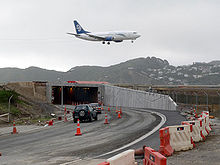 An Air New Zealand Boeing 737 landing in 2006, with construction of the south end runway safety area in the foreground.
An Air New Zealand Boeing 737 landing in 2006, with construction of the south end runway safety area in the foreground.
Vincent Aviation has a small passenger lounge on the Western apron which is used for air charters. The Life Flight Trust operates a hangar to the south of Vincent Aviation's two hangars.
In April 2009, the airport issued a new master plan outlining upgrade plans over the next 20 years, including expanded terminal and apron space, and scope for runway extensions. [6] [7]
Access
Wellington Airport's access is by road.
The airport lies at the southern end of the North Island section of State Highway 1, which connects the airport to Wellington City via the Mount Victoria Tunnel. SH 1 then continues to the Wellington Urban Motorway, which takes traffic out of the city and further afield to Porirua and the Hutt Valley, and on to the Kapiti Coast and the Wairarapa. The distance from the airport to the city centre is roughly 8 km (5.0 mi). Several taxi and shuttle companies service the airport, with a fare to the city centre typically costing NZ$25-35 for a taxi and NZ$14–16 for a shuttle
Two Metlink bus routes service the airport. The major route is route 91 "Airport Flyer", which connects the terminal with central Wellington and Wellington Railway Station, then Lower Hutt and Upper Hutt. The second is Route 11 (Seatoun), which stops within a five-minute walk of the terminal. Connections to Porirua, Kapiti Coast and Wairarapa requires changing to a Metlink train at Wellington Railway Station.
Public transport to the airport is limited to buses as the Airport is quite distant from the Wellington Railway Station, making it difficult to link Wellington Airport to the CBD via a rail link. Feasibility studies, such as the New Zealand Transport Agency's Ngauranga to Airport Study, have been carried out to address this gap in the network, with light rail being touted as a solution by public transport advocates.
Previous Stop Metlink Bus Services Next Stop Terminus Route 91
Airport FlyerKilbirnie Shops
towards Upper HuttIncidents
In spite of the short runway and frequent winds, there have been very few safety incidents at the airport. However, at the air show held on opening day in 1959 there were two significant incidents. A Royal New Zealand Air Force Sunderland flying boat scraped its keel along the runway during a low pass in turbulent conditions; it returned to its base at Hobsonville and was beached for repair. A Royal Air Force Avro Vulcan bomber aborted its landing when it touched down short of the runway, rupturing its left main landing gear drag link, the wing attachments and engine fuel lines; the aircraft flew to Ohakea air base where it was stranded for several months being repaired.
In 1991 a United Airlines Boeing 747 made an unscheduled landing after its intended destination, Auckland Airport, was closed by fog.[40][41] Although the plane landed safely, all passengers and freight had to be offloaded before it was able to take off again. The plane was originally diverted from Auckland to Christchurch due to fog at Auckland. Whilst passing Wellington, Christchurch was also blanketed by fog. Low on fuel, the flight was diverted to Wellington.
On 21 November 2007, a Cessna 172 owned by Wings over Whales, departing to Kaikoura on a whale-watching trip, flipped onto its roof as it was taxiing onto the runway in strong northerly winds. Two people were on board and escaped with only minor injuries. The airport was closed for approximately two hours.
On 17 June 2008, a Pacific Blue 737-800 was moved sideways away from an airbridge after a strong gust of wind caught the tail section. Although passengers were disembarking at the time and ground crew were working under the aircraft, no-one was injured.[42]
Airlines and destinations
Airlines Destinations Pier Air Chathams Chatham Island South Air New Zealand Auckland, Christchurch, Dunedin South West Air New Zealand Melbourne, Sydney
Seasonal: NadiInternational Air New Zealand operated by Air Nelson Dunedin, Hamilton, Invercargill, Napier, Nelson, New Plymouth, Rotorua, Tauranga South, South West, Central Air New Zealand operated by Eagle Airways Blenheim, Gisborne, Palmerston North, Taupo, Timaru, Wanganui, Westport, Whakatane, Whangarei South, South West, Central Air New Zealand operated by Mount Cook Airline Christchurch, Dunedin, Hamilton, Queenstown, Napier South, South West air2there Blenheim, Paraparaumu South Golden Bay Air Seasonal: Takaka South Jetstar Airways Auckland, Christchurch, Queenstown [begins 22 December][43] North West Qantas operated by Jetconnect Melbourne, Sydney International Sounds Air Blenheim, Kaikoura, Nelson, Picton South Vincent Aviation Greymouth, Wanaka, Blenheim, Kaikoura, Nelson, Picton, Napier, Taupo, Keri Keri, Auckland South Virgin Australia operated by Pacific Blue Brisbane International References
- ^ "Wellington (NZWN) aerodrome diagram". Civil Aviation Authority. 2009-11-09. http://www.aip.net.nz/pdf/NZWN_51.1_51.2.pdf. Retrieved 2010-01-04.
- ^ a b "Business statistics - Wellington International Airport". http://www.wellington-airport.co.nz/html/business/statistics.php. Retrieved 2009-12-08.
- ^ "Wellington Airport: Frequently Asked Questions". Infratil. Archived from the original on 2007-09-28. http://web.archive.org/web/20070928035456/http://www.infratil.com/wellington_international_airport_faqs.htm#q2. Retrieved 2007-12-05.
- ^ http://www.teara.govt.nz/en/aviation/11/2
- ^ http://www.virginmedia.com/travel/destinations/features/scariest-airport-landing-strips.php?ssid=7
- ^ [1]
- ^ [2]
- ^ Flight Magazine, 11 September 1947
- ^ Flight Magazine, 5 October 1956
- ^ [3]
- ^ [4]
- ^ "Norwest Business Forum presentation". Enterprise North Shore. 2007-03-23. http://www.ens.org.nz/site/ens/files/Norwest%20Business%20Forum/Charles%20Finney%20-%20Whenuapai%20Presentation%20to%20Business%20Forum%20230307.ppt. Retrieved 2007-12-05.
- ^ Wellington City Airport - Wellington City Council Official Brochure and Programme, 1959.
- ^ a b "Update" (PDF). Infratil. 9 September 2005. Archived from the original on 2007-09-28. http://web.archive.org/web/20070928035655/http://www.infratil.com/downloads/pdf/update_sep2005.pdf. Retrieved 2007-12-05.
- ^ AC139-06a
- ^ a b Wellington International Airport Ltd Draft Master Plan (Technical Solutions), Airplan NZ, 1991.
- ^ Page Not Found | Victoria University of Wellington
- ^ Birth of an airport, Juliet O'Connor, Evening Post, 14 June 1999, p5.
- ^ "Runway safety plans bring Wellington Airport in line with new international standards". Wellington International Airport. 2006-10-12. http://wellingtonairport.co.nz/html/business/news.php#20061012. Retrieved 2007-12-05.
- ^ "Alert - number 2" (PDF). Wellington International Airport. May 5, 2006. http://www.wellingtonairport.co.nz/extras/pdf/alert_no_2%20_%205_may_06.pdf. Retrieved 2007-12-05.
- ^ "ACCC proposes to deny Qantas / Air New Zealand Tasman Agreement". Australian Competition and Consumer Commission. 3 November 2006. http://www.accc.gov.au/content/index.phtml/itemId/769527. Retrieved 2007-12-05.
- ^ a b http://www.wellingtonairport.co.nz/html/airportinfo/maps.php#Terminal-Maps
- ^ "Wellington welcomes its longest plane". 3 News. 9 February 2011. http://www.3news.co.nz/Wellington-welcomes-its-longest-plane/tabid/423/articleID/197692/Default.aspx. Retrieved 11 February 2011.
- ^ "Giant Boeing lands at Wellington - stuff.co.nz". 9 February 2011. http://www.stuff.co.nz/dominion-post/news/4628478/Giant-Boeing-heading-to-Wellington. Retrieved 11 February 2011.
- ^ http://www.airnewzealand.co.nz/press-release-2011-extension-of-50-dollar-domestic-fares-and-further-additional-capacity
- ^ Wellington's Airport: The Costs & Benefits of Alternative Developments, C. Gillson, NZIER, 1970.
- ^ Study of the Development of Wellington Airport, W. D. Scott & Co (NZ) Ltd, December 1979.
- ^ Wellington International Airport Master Plan, J.H. Fyson, Wellington City Council Works Department, 1985.
- ^ Horizons Manawatu Fact Sheet/Background Information for Cargo Hub Report, 2002, p4.
- ^ "Air NZ drops Christchurch-LA service". New Zealand Herald. January 25, 2006. http://www.nzherald.co.nz/section/3/story.cfm?c_id=3&objectid=10365291. Retrieved 2007-12-05.
- ^ "Wellington airport plan riles Air NZ". TVNZ. August 5, 2005. http://tvnz.co.nz/view/page/425829/602177. Retrieved 2007-12-05.
- ^ "Push to extend Wellington airport" - Dave Burgess, The Dominion Post, 18 July 2011.
- ^ "Qantas Use Of 747SP In The 1980s". Airliners.net forum. http://www.airliners.net/discussions/general_aviation/read.main/2602745/1/#1. Retrieved 2007-12-05.
- ^ "Red, White And Q Farewell For Qantas Aircraft". Qantas Airways. 4 March 2002. http://www.qantas.com.au/regions/dyn/au/publicaffairs/details?ArticleID=2002/mar02/2645. Retrieved 2007-12-05.
- ^ New design for airport terminal 'hideous', Greer McDonald and Nick Churchouse - The Dominion Post, Thursday, 21 February 2008.
- ^ "The Rock Takes Shape At Wellington Airport". NZPA. February 1, 2010. http://www.guide2.co.nz/money/news/business/the-rock-takes-shape-at-wellington-airport/11/13876.
- ^ "Wellington Airport: Frequently Asked Questions". Infratil. Archived from the original on 2008-01-08. http://web.archive.org/web/20080108062415/http://www.infratil.com/wellington_international_airport_faqs.htm#q7. Retrieved 2007-12-05.
- ^ "Wellington Regional Chamber of Commerce presentation" (PDF). Wellington International Airport. 1 August 2006. http://wellingtonairport.co.nz/extras/pdf/pres_chamber_commerce_final.pdf. Retrieved 2007-12-05.
- ^ "Airport Retail Park". ArcHaus Architects. http://www.archaus.co.nz/projects/project.php?pid=23. Retrieved 2007-12-05.
- ^ The Dominion, 9 October 1991, p.3; The Dominion, 24 June 1999, p3
- ^ http://www.askcaptainlim.com/asflyfs2002.htm#I
- ^ Plane 'blown away' as passengers disembarked - 8 August 2008 - NZ Herald: New Zealand National news
- ^ http://www.jetstar.com/mediacentre/latest-announcements/detail?Id=899df8a7-a6b7-44e3-a881-155ddf519d68&language=en
External links
- Wellington International Airport official site
- Airliner photos at Wellington International Airport (Airliners.net site)
- NZWN Details on AviationPage New Zealand
- Information about Wellington International Airport
- New Zealand AIP Operational Data Pages
- Information of what you can do at Wellington Airport if your flight is delayed - LateDeparture
Categories:- Wellington City
- Airports in New Zealand
- Airports established in 1959
Wikimedia Foundation. 2010.

